How to Compost Your Fall Leaves Quickly . . . so easy . . .
. . . a parameceum could do it . . . I wanted to add that, but then I reminded myself not to get too cute with my title. Or too long. That’s advice I’m taking this week. I may change my mind on that.
We’ll see.
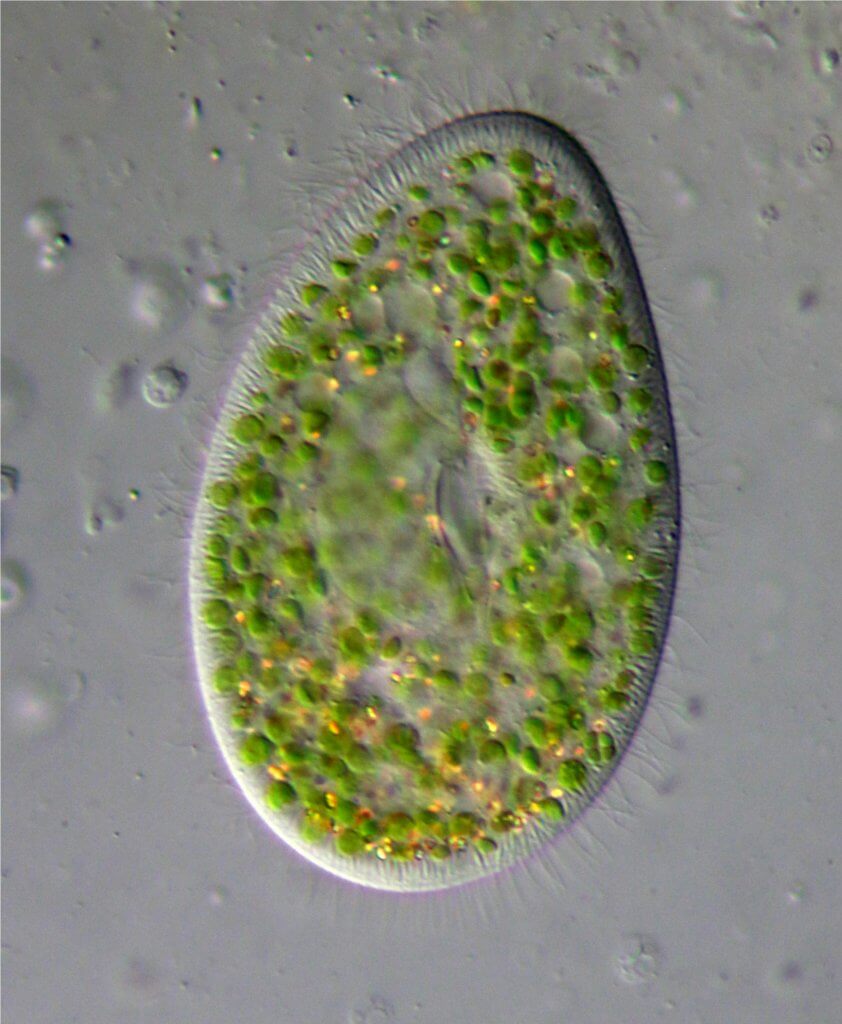
A single-celled paramecium, photo credit Wikipedia By Picturepest –
I’ve been in a fever lately–of end-of-season-fidgety-squirrel-productivity. I’ve made not one, but two beautiful compost piles, and believe it or not: I’m working on a third.
Somebody pinch me. Is this a dream, or I am really lucky enough to have three compost piles cooking away, destined to be the most marvelous soil amendment you can imagine?
Furthermore, as I’ve made these beautiful, leaf-filled towers of garden joy, I’ve thought about you, gentle reader. You cause me to muse over compost. Or (more accurately) vice-versa. (That’s a compliment. Lest you wonder.)
Many of you have admired the photos of my beautiful heirloom tomatoes, pretty edible flowers, and my lush and life-enhancing herbs, and you’ve made comments like “What’s your secret?” and “My tomatoes don’t look like that,” and so on. Also: “Amy, you’re amazing,” <—-(my fave)
And as I built my compost piles this fall, the thought occurred to me . . . I need to spill the beans on my secret, to wit: (Are you ready?) Growing a beautiful, healthy garden is much easier when you add plenty of compost to your soil every year.
That’s it.
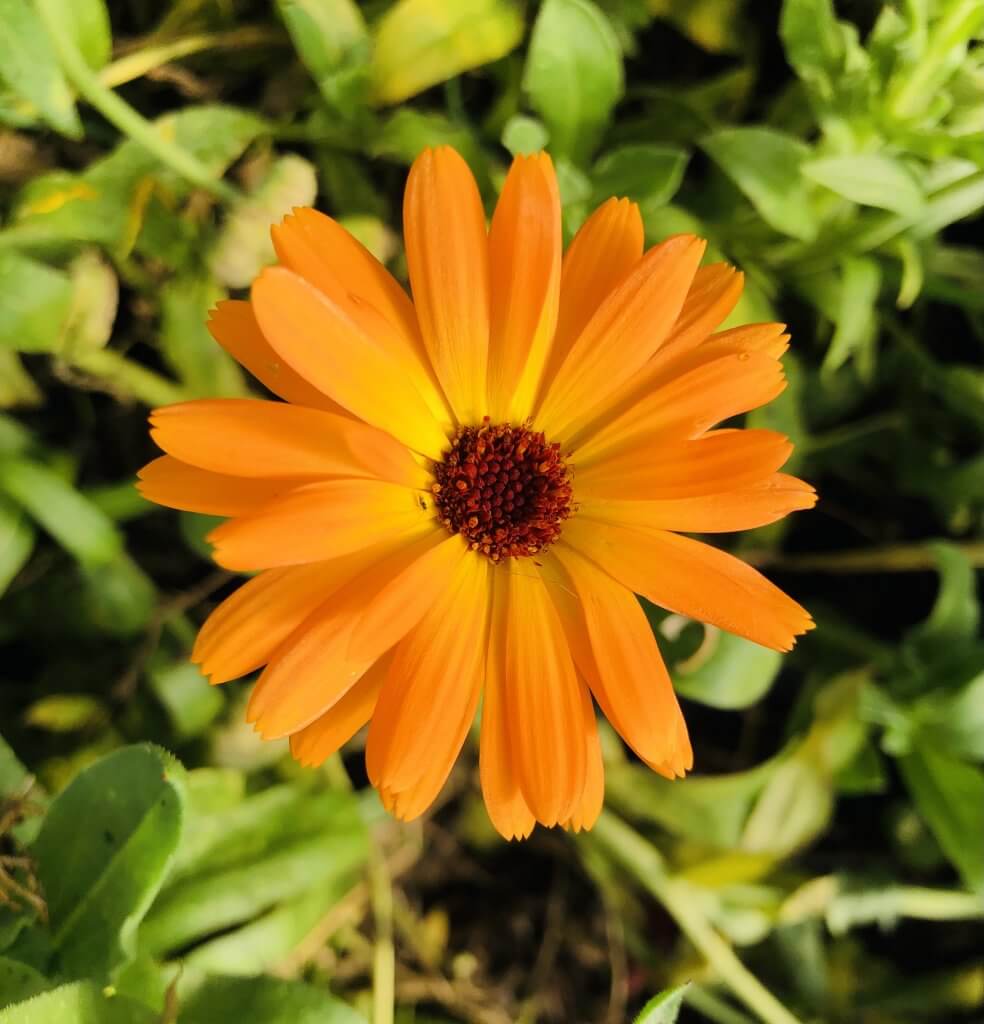
Calendula officinalis
But. Don’t drop your ‘phone now and rush to the store to buy o’erpriced bags of something called “compost,” lug it home and dump into your garden. I mean, it won’t hurt, but that’s not the compost we’re talking about here today. (Most places around here ran out months ago, anyway.)
What I’m referring to is your own compost, that you make this fall, let sit and biodegrade over the rest of the fall, winter, and early spring. I make it every fall, and it brings me such joy. As I clean up my yards, gardens and flower beds, I am a busy bee, hauling all the grass clippings and leaves to the compost piles that I’m building. This work is just perfect for the season: it’s a mindless (in a nice way), utterly doable, simple, tidying, and satisfying fall task.
And no, it’s not too late to do this, unless your ground is already covered with ice and snow.
My process–in contrast to many of the complicated tutorials you’ll find on the interwebs–is so easy, an infant could do it. A monkey. A single-celled paramecium (above) would have the skills necessary to build the compost piles that I make each fall. If it had legs and a few more cells. And arms.
And a teeny tiny parameceum-sized pitchfork.
You won’t need a college degree in horticulture to understand my directions either. No sirree bob.
I intend to SHARE ALL in this post.
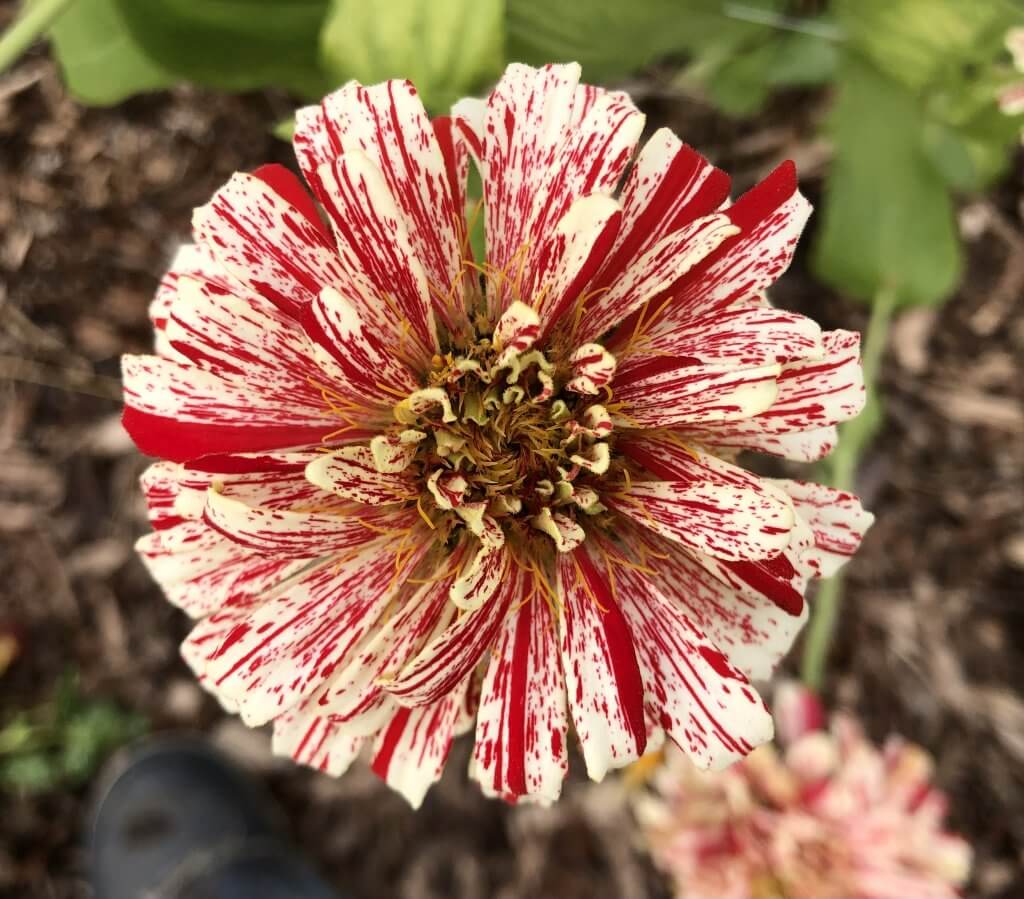
But first: why might you set aside a tiny modicum of time to build compost piles in the fall? I’ll give you a few reasons why you must consider doing this:
- Falling leaves are God’s gift to gardeners. Left to rot, they will enhance the soil they rot into, but gathered up, chopped, piled up, wet down, covered and mostly left alone for several months, they will turn into a lovely, crumbly, worm-filled, glorious substance and will make the perfect soil enhancement by the next growing season.
- Making compost piles in the fall (or even early winter) will allow the time needed for bacteria to work its magic of decomposition on the leaves, turning it into compost.
- You may have to pay somebody to haul your leaves away, in many areas. (Imagine.)
- You will be the smart one in the neighborhood if you do this, and in the ensuing years, when you sweep all the Finest Vegetables awards at the county fair, you’ll have your fall compost piles to thank. (And me, of course–she blushingly admits.)
- Beautiful tomatoes, stunning peppers, eye-smashing flowers, and more.
Glory, glory, we’ve had a mild, long fall, and I have kept working on pruning the orchard, socking away fall crops for winter use, cleaning up flower beds, hauling mulch, hauling leaves, cleaning up, spreading mulch, gathering acorns and hiding them in the crook at the top of the Old Oak Tree, planting hoophouse beds, and whatnot, until now–early December.
It has been utterly, almost unbelievably lovely.
This type of autumn is so totally on the other end of the spectrum from the years when we get a huge dumping of wet snow around Halloween, and I must avert my shamed eyes from an unpruned orchard, unmulched gardens, and untidy flower beds all the winter long. Ungathered acorns, yes, yes, those too.
However, there’s one entity that benefits a great deal from an early and severe winter: that would be my house.
Most years, by early December, after all, I’m indoors for most of the day, and knee-deep in cleaning up months’ worth of dust, dirt, piles of junk, drifts of dog hair, etc.
(Do I protest too much, gentle reader?)
On the other hand, all through a long, lovely autumn like the one we’re enjoying, I know, all the time, every blessed minute, what I always know–that once the snow flies, and the ice coats everything in sight for weeks at a time, and the wind howls and turns your nose hairs into painful little icicles, I will gratefully stir up the wood fire, take a long appraising glance around at the indoors havoc that my addiction to being outside wreaks, dig in with gusto, and stay the heck inside. <—-Winner of longest sentence award goes to . . . .
Erm . . . . Mostly. That is. I do still stubbornly bundle up and go for a walk every day that I can, EMBRACING THE NORTH WIND to get my chores done. I layer, and breathe in the lovely scent of winter. That crispness! The sharp bite of cold. And I will take snow photos until my fingers freeze, and admire the tracks in the snow and other things too.
*siiigh* I’ll admit: I am the hapless victim of my passion for being outside.
This will be on my tombstone. Some day. Hopefully in the far distant future.
HERE LIES AMY
AT LAST, SHE DIED
SHE ALWAYS PREFERRED
BEING OUTSIDE.
Now that I’ve written my tombstone epithet, let’s return to the subject at hand: building your fall compost pile.
Guess what? Several weeks ago I realized that it takes me a scant 10 minutes (10 minutes, gentle reader!) to run our little riding mower with the eager, sucking bagger on the back, around a leafy portion of our yard and then return to the garden with three heavy bags full of the nicest, most aromatic and beautiful combination of grass clippings and chopped up leaves. Honestly–10 minutes! For some reason at which I can’t even guess, I assumed I didn’t have time to do this.
BOY, WAS I WRONG-O! I actually do! Have the time, that is. Even on the busiest day, I have a scant 10 minutes to spare.
And that brings me to the question I am dying to ask you and every other person I see.
To wit.
Why aren’t you making a compost pile out of your fall leaves?
The residents of a nearby city have this charming habit of raking up their fall leaves and putting them into large paper bags and putting them out on the curbside for the trash man to pick up. My son (who lives in this nearby city) says that they are billed $2/bag for the privilege of sending their fall leaves to the dump. I don’t know what the trash man does with the leaves, actually. If he’s a smart trash man, he makes the leaves into compost and then in the spring sells it back to the tidy city dwellers.
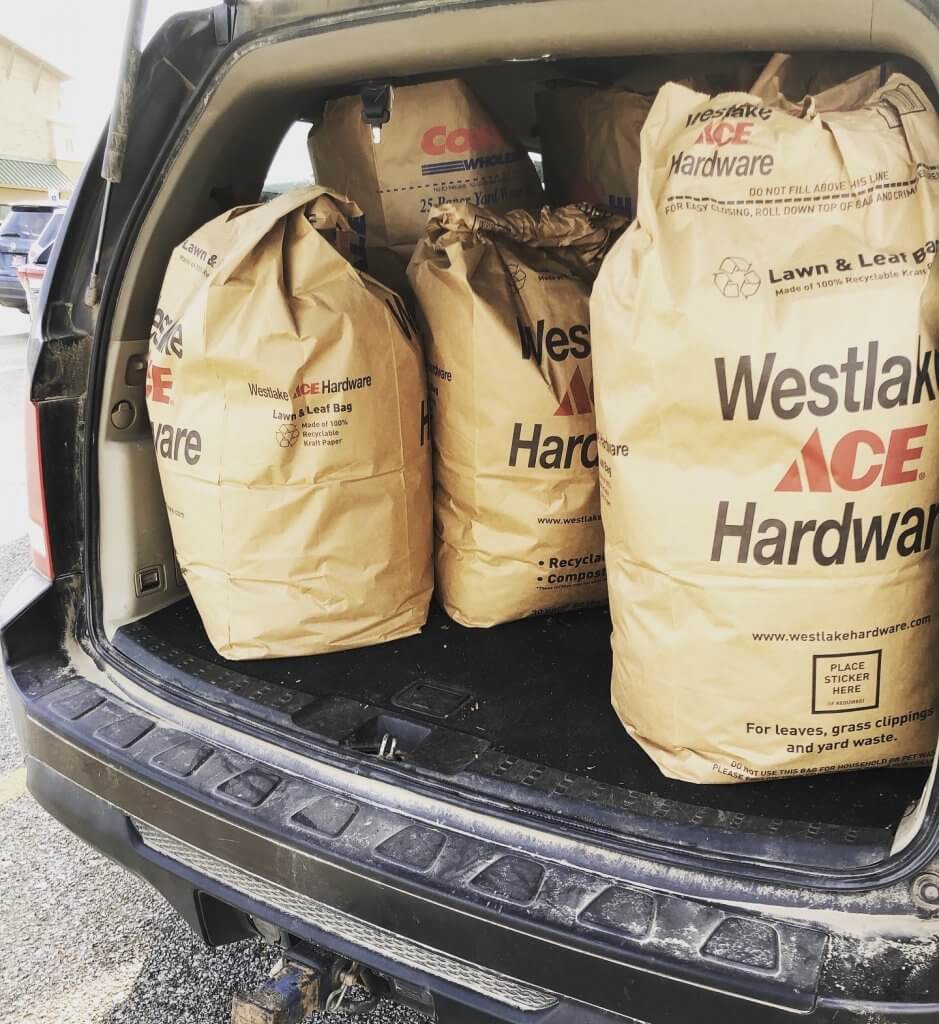
This is what my SUV looks like in the fall, when I come home from the city.
That’s what I’d do.
Okay, on to the simple recipe for making your own compost pile. You have my permission to ignore the complicated formulae you’ve read before on making a compost pile. That long article on the interwebs that you exhausted yourself trying to slog through. Ratios, and pie charts, and statistics, and whatnot.
First, the thumbnail version:
How to Compost Dry Leaves Quickly
- Make a circle with a length of garden fencing.
- Chop or shred leaves and dump a layer several inches thick in the circle.
- Add a layer of grass clippings on top of the layer of leaves.
- Continue the layers until the pile is full.
- Extra credit: Add a shallow layer of chicken or horse manure somewhere in the middle.
- Wet the pile down until it’s as damp as a well-squeezed-out sponge.
- Cover the entire thing with a big sheet of plastic and weigh it down with a few bricks so it doesn’t blow away in the next storm.
- To hasten decomposition, turn the pile once per month. This is optional, however.
Now onto the longer version, with pictures!
Never fear. All you really need is leaves. If you have a few buckets of chicken manure, and if you also have some grass clippings, it’s even better. But all you really need is leaves.
How to Compost Your Fall Leaves Quickly
–like a parameceum–
. . . which will be a glorious heap of finished compost next summer!
1. Take a length of garden fence and make a circle with it.
IF you want to get fancy, start with a layer of coarse weeds or branches, to encourage air movement at the bottom of the pile. If that sounds too complicated, skip it.
2. Chop or shred your leaves and dump a layer several inches thick into the circle.
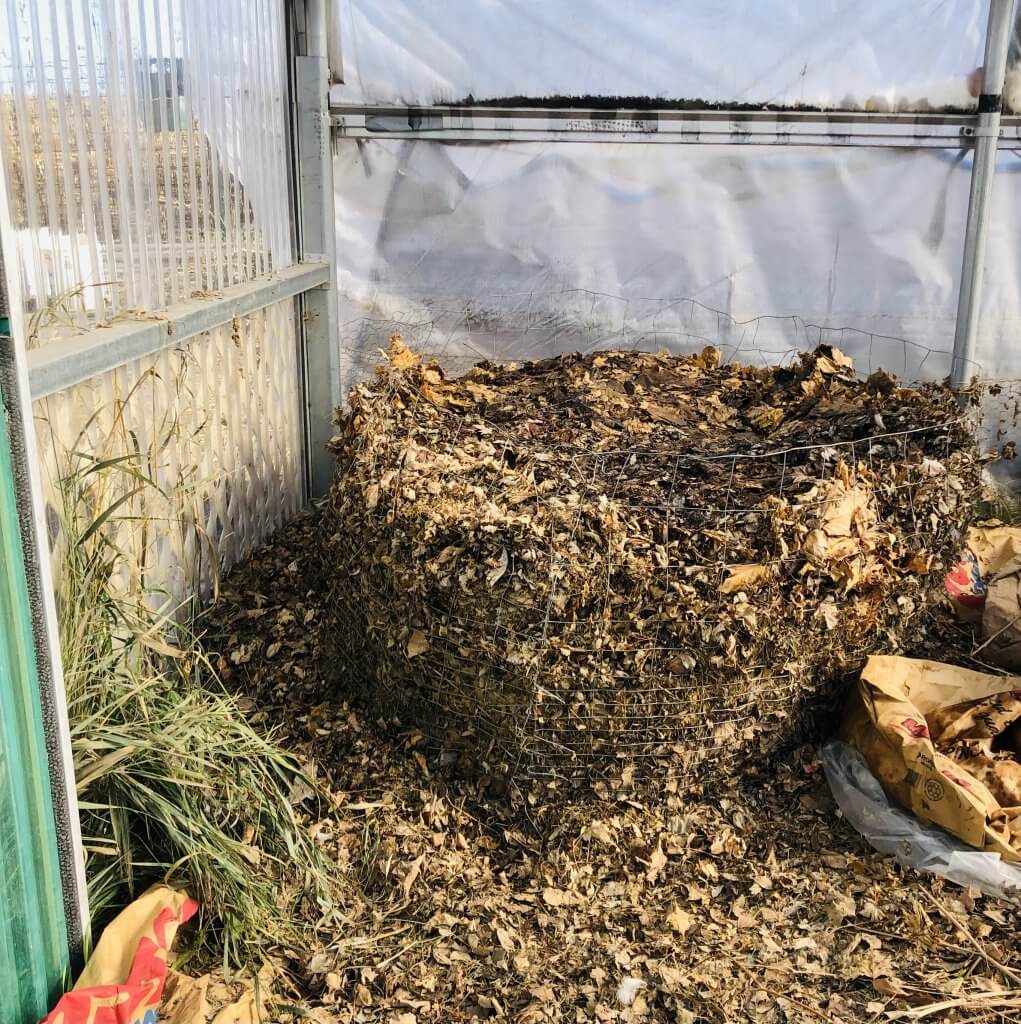
BY THE WAY . . . If you are a smart cookie, you’ll ask Santa to bring you one of these. It’ll chop up your leaves like nothing else, and chopped up leaves will decompose about a hundred times faster than whole leaves. But if you don’t have one, don’t fret. You can hack at them wildly with a hoe, or even run over them with a mower (that’s what I do, the latter).
3. Add a smaller layer of grass clippings to the pile of leaves.
Again, the mower is a wonderful tool.
4. Wet the pile down, until it’s as wet as a well-squeezed sponge.
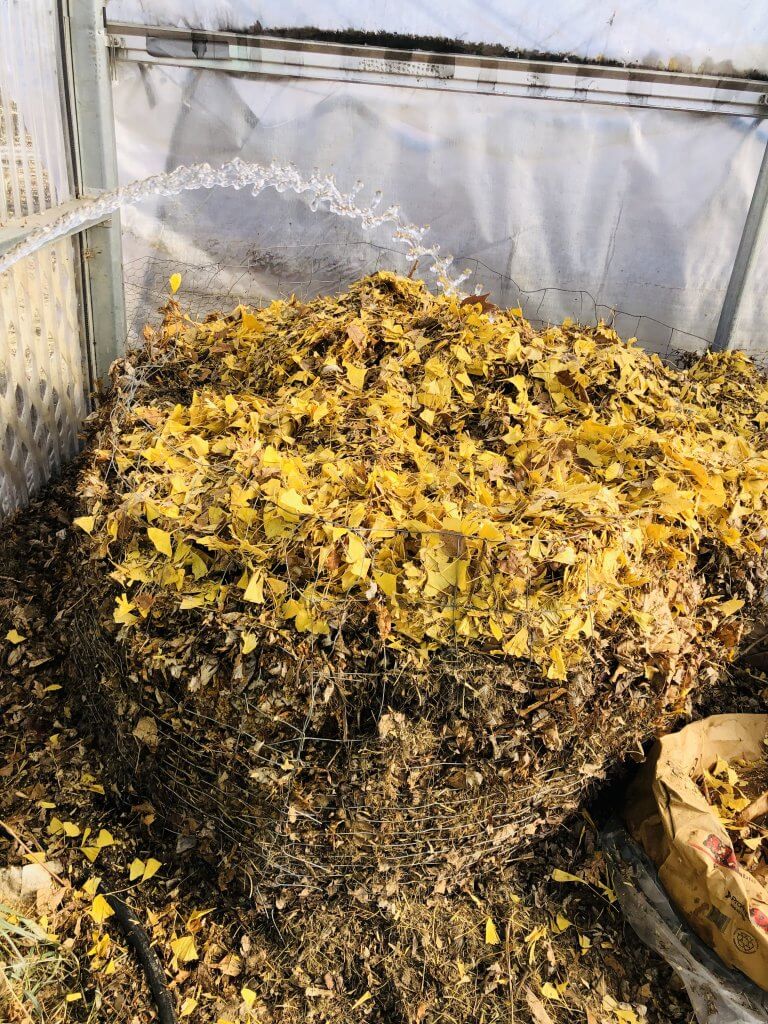
A friend gave me several bags of ginkgo leaves!!
5. Add another thick layer of shredded leaves, a thin layer of grass clippings, then sprinkle it all again.
It will settle. You may want to add another layer or two, after a few days.
6. If you can get your hands on a bucket of chicken manure + bedding, or horse manure, kiss your benefactor and add a thin layer of this.
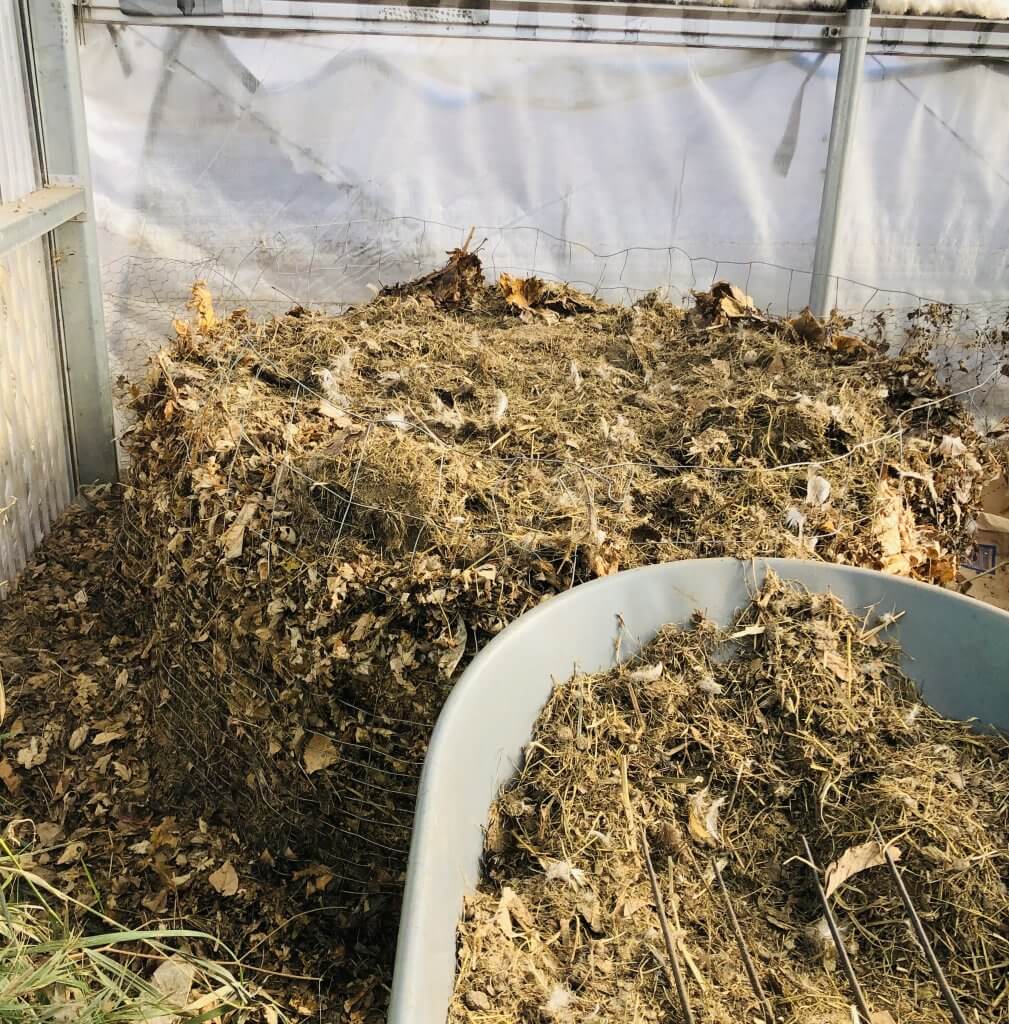
I kiss my chickens every day for this miraculous substance. Metaphorically kiss them. Wave kisses at them.
7. You know the drill: Repeat all the layers until your pile is heaping, overfull. (It will settle more than you think.)
You’re beginning to feel quite proud of yourself. You’ve gotten some good exercise, a bit of sunshine, and you’re nearly there.
8. Do a happy dance. You’re doing good. Now cover the entire thing with a big piece of plastic.
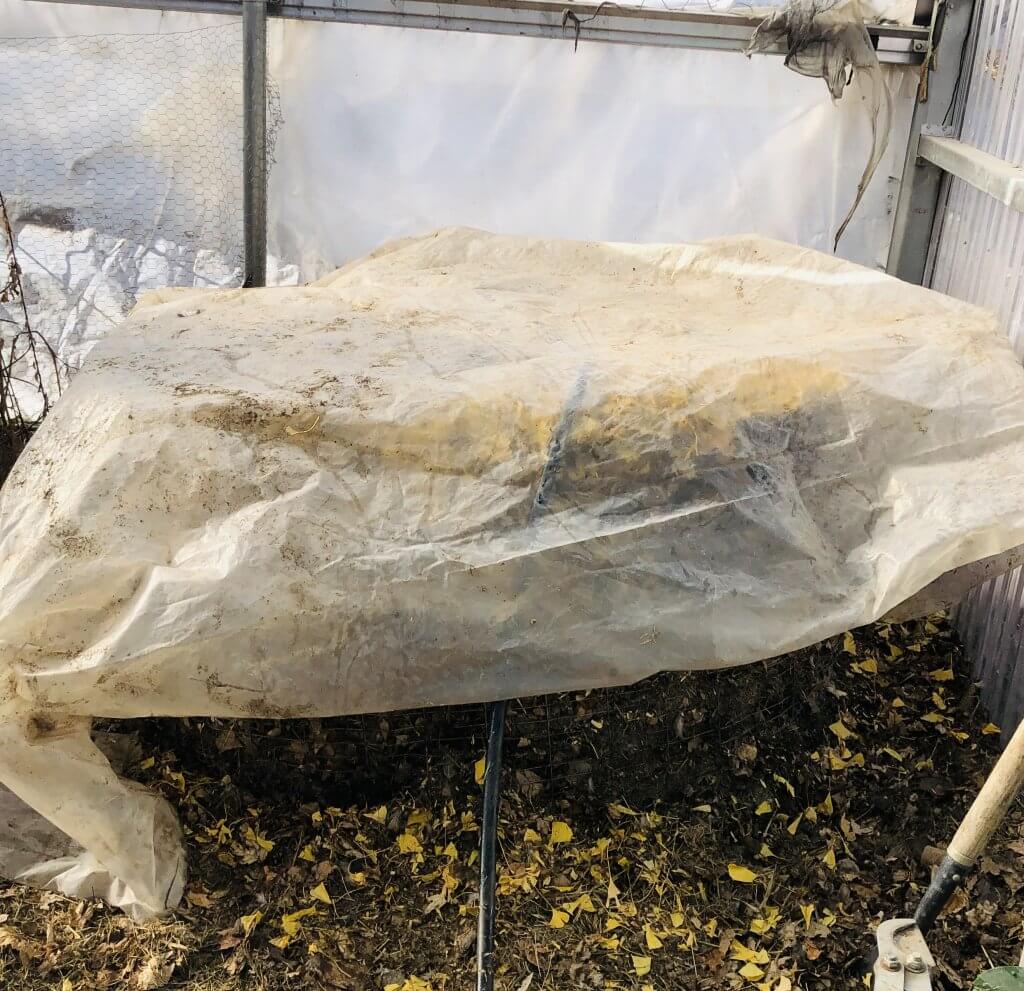
Leave some space for air circulation at the bottom. Don’t wrap it too tightly.
9. On pleasant sunny days, fling off the plastic, and grab a handful . . .
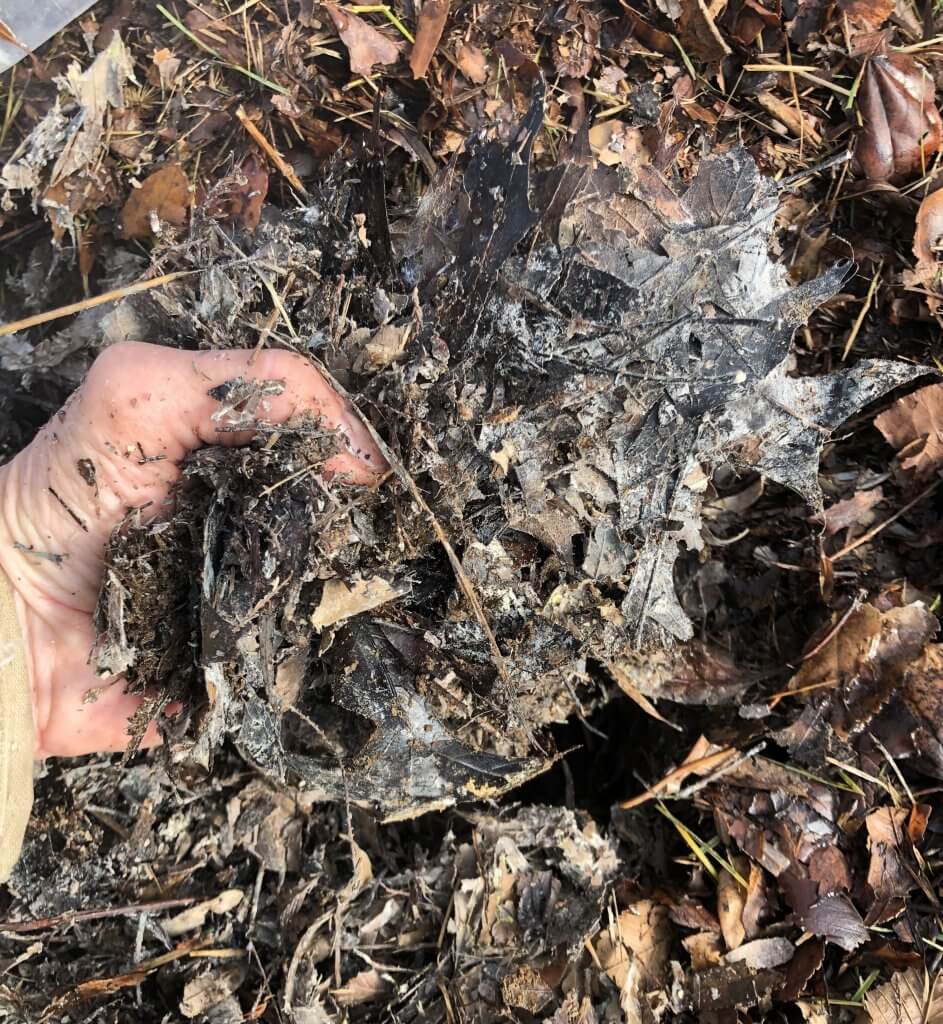
Gorgeous! This is leaf mold, which is also great to use in your garden. Left alone, though, it will continue to decompose and become even more beautiful by springtime. It also is HOT.
. . . if it’s dry, sprinkle with more water, then put the plastic back on.
10. Again, if you want a faster decomposing pile . . .
. . . and who doesn’t??–use a thermometer to check the temperature every couple of weeks. The zone where the magic happens is between 130 and 140 degrees F.
11. If the compost pile falls below that temperature, you can turn it with a pitchfork . . .
. . . which aerates the pile, and it will heat it up again. Or check out this Youtube video for an easier option which will heat it up too. If the temp gets higher than that, take off the plastic “lid” and sprinkle with water. (Mine rarely gets higher, though, as it cools down at night.)
Now. For those of you who may want to dig a little deeper . . . permit me . . .
just a few lines of compost geekery
A simple rule of thumb: If you use both dry leaves and grass clippings (highly recommend!) to achieve the best carbon-to-nitrogen ratio in your compost, put in two to four parts brown materials for every one part green materials. If you get too much carbon (the leaves) the pile won’t heat up enough. On the other hand, if there’s too much nitrogen, it’ll be stinky and slimy. You may notice one of these problems, and if you do, simply add more of the element you’re missing to fix your ratio.
Temperature: Hot composting–which is much faster at breaking down the raw materials than “cold” composting–and is what I aspire to–is achieved when the balance of greens, browns, air, and water creates ideal conditions for aerobic organisms to thrive. The optimal peak temperature for aerobic composting is 130 to 140 degrees F, which happens when aerobic macro- and microorganisms are breaking down waste and reproducing at a fast rate. This high temperature also kills any lingering bacteria, parasites, bugs, or weed seeds. Say it with me: Happy. Dance.
To Turn or Not to Turn: that is the question. My thoughts on this: if your pile cools down below 130–160F range, it’s not biodegrading very quickly any longer. If you’re okay with it taking longer to make your compost, put your feet up and pour yourself another glass of ice tea/kombucha/sparkling water/hot chocolate/etc. But if you feel like a little exercise, and need to get some sun anyway (you probably do, admit it), pull out your pitch fork and turn that pile! Either way: I won’t judge. After you turn it, it should heat up again for a few weeks or even longer. As long as it’s heated up, it’s degrading and you ought to be good to go.
One more thing: if you decide that turning your compost every few weeks is for you, take a look at this Youtube video. Food for thought, food for thought. I’m trying this non-turning technique this winter.
And here are some fun things you can buy to make compost-pile-making even more fun:
Compost Thermometer
And yes, it’s a thing. I’m not making this up. It’s amazing.
Leaf shredder
I want one of these. Desperately. I hope the Hubs sees this. It would look great under the tree this Christmas.
Wire Garden Fencing
I trash picked some! Boom! #winningatlife But of course you can buy it too.
Pitch Fork
I own several. “People” always borrow mine, and then leave them out in the rain (cough) so the wooden handles are rough and splintery. I admire these fiberglass handled ones. And yellow! Nice. Cheerful. Unsplinterable.
Some Decent Gardening Gloves
get two. Better yet, four!
So there you go, gentle reader. I’ve spilled the proverbial beans. Making compost like this every fall, primarily from the fall leaves that end up on the ground around our place, is the secret to my success in growing lovely garden produce. (At least it’s a BIG part of it.)
Now if you’d like to hear Bethany and me chatting about compost, click on over to our Sweet as Love podcast for more composty stuff!
If you enjoyed this content, could I ask a favor? Would you please share this with a friend or relation who might enjoy it, as well? It will let me know if this is helpful for you.
Also, if you’re still working on Christmas lists, please take a look at my blog shop!
I’ve got a slew of beautiful new French rolling pins, made by my congenial geezer dad, and some very pretty new Colonial butter knives, too. Take a look: you might want buy a few for stocking stuffers!
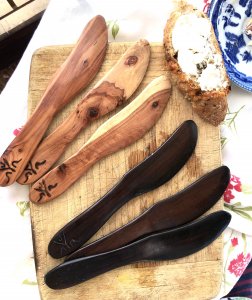
New Colonial butter knives are in my shop!
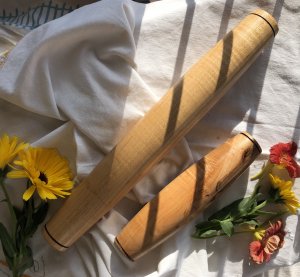
The “Mommy and Me” set in Maple.
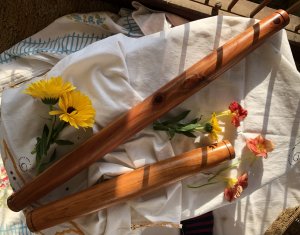
The full-sized cherry pin is shown here with its pal, the “Bitty.”
Thanks again for popping in!
*hugs*
- Paintbrush Cookies: a sweet heritage Christmas cookie recipe
- How to Lose Weight in Middle-Age (& beyond . . .)








You go girl! I’ve got a dozen of those big brown paper bags filled with leaves from my daughter’s in-town house but I haven’t got them into a working compost pile yet. As an organic food farmer for the last thirty years I can definitely back you up on compost being the absolutely best way to get your soil healthier and keep it healthy, but it is not a one and done effort. One needs to do it the way you do it – year after year. (Darn – those chickens are good for more than eggs and meat! that’s what I don’t have right now!)
Gene, I keep trying to talk you into getting a few chickens . . . you wouldn’t regret it! in lieu of that . . . I can supply you with chicken manure + bedding any ole’ time. Just bring a few buckets out!
Sadly, although I get a lot of leaves every fall, 90+ percent of my trees are oak. I won’t add many oak leaves to my compost. But I do have lots of chicken bedding and manure, besides garden waste, so I have plenty of compostable material.
Ahh I can see you are knowledgeable about leaves in compost: oak leaves (at least in quantity) are a no-no. It’s hard to resist, though, when you have a lot of oak leaves. We have several oak trees now that are big enough to drop a decent amount of leaves in the fall. I mowed over them a few times to shred them and then just added them in small quantities. I try not to let any leaves go to waste at our place!
I have cedars, so have to get my leaves from the bags neighbors leave on the curb, or posts on Craigslist. Yes, my area residents post leaves! Otherwise, they go in our big green trash bins, and the disposal company composts them, along with all the other green waste, and bags it up for sale. I think those of us who pay for the green bins should get a discount. They get their raw material free, then sell it back to us! I run my mower over the leaves and spread it directly on my beds. It doesn’t break down completely by spring, but enough to plant through. Pretty soon you can’t tell they were even there.
I did get some with acorns one year, and that was work picking them out, then pulling out the seedlings.
lisa, that’s a lovely tale. Occasionally I find offensive things in the bags that I pluck off the curbs: just regular trash, doggy-doo-doo bags that walkers probably deposit, and other stuff. And I’ve had the acorns planted unwittingly all over my beds before too! Oh well. I figure beggars can’t be choosers. (I’ll let you know if I ever find anything valuable . . . !!)